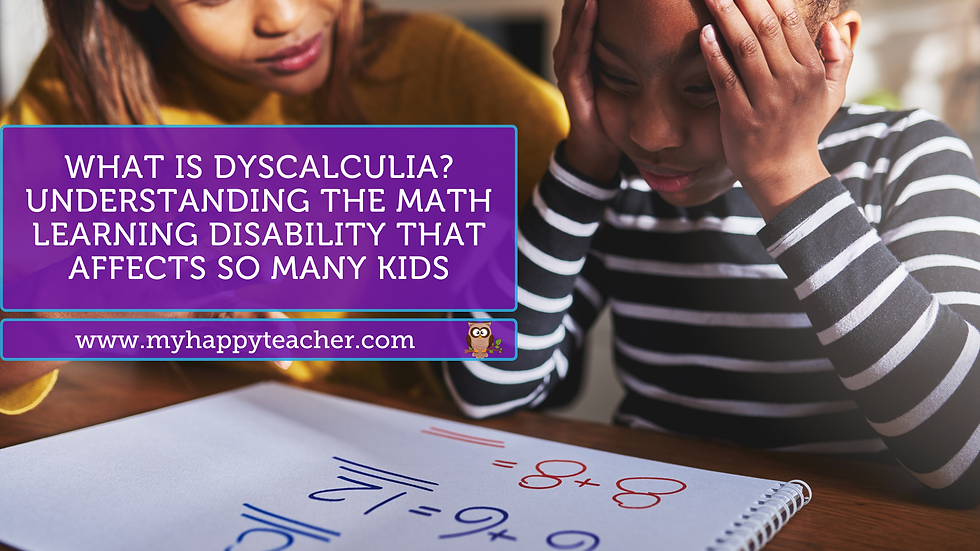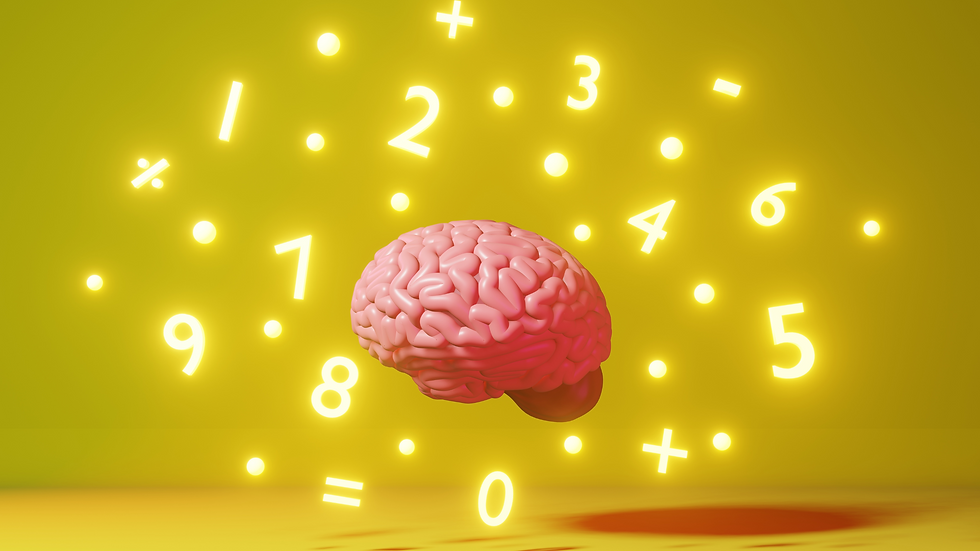What Is Dyscalculia? Understanding the Math Learning Disability That Affects So Many Kids
- Kathy Cousineau

- Jul 14
- 6 min read

Does your child get frustrated with math, even when it seems like they’re trying their best? Do they struggle to remember math facts, get confused with directions, or take much longer than their peers to complete math assignments? If so, it could be more than just disliking math. Your child may have a learning difference called dyscalculia, and you’re not alone.
In this parent-friendly guide, we’ll break down:
What dyscalculia is
How it differs from typical math difficulties
The signs to look for, and
How you can support your child both at school and at home.
This article is packed with helpful tools, tips, and compassionate advice so you can walk away feeling empowered, not overwhelmed.
What Is Dyscalculia?

Dyscalculia is a specific learning disability that makes it difficult for a person to understand numbers and work with them. It’s sometimes called math dyslexia, but it’s not just being "bad at math." It’s a neurodevelopmental condition that affects how the brain processes numerical information.
A child with dyscalculia may:
Struggle with basic math operations like addition, subtraction, multiplication, and division
Have difficulty with number sense, such as estimating or comparing numbers
Find it hard to understand directions or sequences in a math problem
Forget math facts even after lots of practice
Dyscalculia doesn’t mean a child isn’t smart. Many children with dyscalculia are very bright and creative, but their brains process math differently. This specific learning disability affects about 3-7% of the population and can make everyday tasks—like telling time, paying bills, or making change—more difficult.
What Are the Signs of Dyscalculia?

Not every child who struggles with math has dyscalculia. However, there are some common signs that may point to this learning disability:
Frequent confusion with numbers and symbols
Difficulty remembering math procedures or steps
Taking a long time to solve even simple math problems
Struggles with word problems or real-life math-related scenarios
Difficulty estimating quantities or understanding measurements
Trouble telling time or remembering schedules
Anxiety or frustration related to math tasks
You might also notice your child with dyscalculia avoids math homework, becomes upset when asked to do math in public (like figuring out a tip), or seems to forget math facts soon after learning them.
How Does Dyscalculia Affect Daily Life?

The impact of dyscalculia goes far beyond the classroom. Mathematics is everywhere—from following a recipe to managing money.
Children with dyscalculia may have a harder time:
Learning to tell time using an analog clock
Counting money and making change
Understanding time management or durations
Playing board games that involve numbers
Estimating distances or visuospatial reasoning tasks
As they grow older, adults with dyscalculia might struggle with paying bills, budgeting, or even remembering directions. This can affect confidence, independence, and long-term success. But with the right support, people with dyscalculia can thrive.
What are the Possible Causes of Dyscalculia?

Research shows dyscalculia is caused by a combination of genetic,
neurological, and environmental factors. Here’s what we know about the possible causes:
Genetics: Dyscalculia can run in families. If you or a relative had
math struggles, your child might too.
Brain Development: Neuroimaging shows that people with dyscalculia process numbers in different parts of the brain than their neurotypical peers.
Other developmental disorders: It’s common for dyscalculia to occur alongside dyslexia, ADHD, or autism spectrum disorders.
Environmental Influences: Limited exposure to early number play or poor instruction can make dyscalculia harder to detect and support.
💡Remember: dyscalculia is not the result of laziness or lack of effort. It is a real, brain-based learning disorder recognized in the DSM-5.
How Is Dyscalculia Diagnosed?

If you suspect your child may have dyscalculia, the first step is to get a formal evaluation. A diagnosis of dyscalculia is typically made by a school psychologist, neuropsychologist, or educational evaluator using several diagnostic tests.
These often include:
Cognitive testing (e.g., the WISC)
Achievement tests that measure math learning skills
Observations and interviews
Input from teachers and parents
The evaluator will rule out other issues, like intellectual disabilities or sensory impairments, and compare your child’s math abilities to age-appropriate benchmarks. A diagnosis of a specific learning disorder in mathematics can open the door to school supports and services.
How Do Kids with Dyscalculia Learn Math?

Children with dyscalculia can learn math, but they often need different approaches. Traditional methods that rely heavily on memorization, speed drills, or rote practice may not work well.
Instead, they benefit from:
Hands-on, visual learning (like using blocks, diagrams, or number lines)
Step-by-step instruction that builds from concrete to abstract
Repetition and overlearning to help with retention
Frequent review and cumulative practice
Strategies that tap into strengths like storytelling, patterns, or visual memory
Just like kids with dyslexia need structured reading instruction, kids with dyscalculia need structured, multisensory math instruction—ideally from trained professionals who understand math-related learning disabilities.
What Can Parents Do to Help at Home?

You don’t have to be a math expert to support your child with
dyscalculia. Here are some practical ways to help at home:
Break math problems into smaller steps
Use color-coded visuals or sticky notes to sequence steps
Make math part of daily routines (cooking, shopping, games)
Practice math facts with songs, rhymes, or story-based flashcards
Limit timed drills; focus on accuracy and understanding
Celebrate small wins and effort, not just the correct answer
📣Also, keep an eye on your child’s emotional well-being. Kids with dyscalculia often feel "dumb" or ashamed. Encouraging a growth mindset and reminding them that they’re not alone can boost their confidence.
What Accommodations Can Help in School?
Many students with dyscalculia are eligible for accommodations under a 504 Plan or an IEP.

Common supports include:
Extra time on tests and math assignments
Use of a calculator, number chart, or math reference sheet
Oral explanations for word problems
Alternative ways to show understanding (e.g., oral responses, visual projects)
Reduced number of math problems or simplified steps
Access to remediation or a special education teacher
✍️It’s important to collaborate with your child’s school team to create a plan that matches their needs. A good accommodation plan can significantly reduce anxiety and increase participation.
What Assistive Technology Tools Can Help?

Assistive technology can be a game-changer for students with dyscalculia.
Some options include:
ModMath: An app that helps students do math on a touchscreen using virtual graph paper
Photomath: Offers step-by-step instructions for solving math problems
Talking calculators: Useful for kids with both dyscalculia and ADHD
Math apps that turn learning into games (e.g., Reflex Math, Prodigy)
🎯These tools can help lessen the cognitive load and make math more accessible and less intimidating.
Where Can You Find Trusted Resources?

You are not alone in this journey. These trusted organizations can offer further support:
Understood.org – Parent-friendly resources about neurodiversity and thinking differences
International Dyslexia Association (IDA) – Also covers dyslexia and dyscalculia
Learning Disabilities Association of America (LDA) – Tools and training for families
National Center for Learning Disabilities (NCLD) – Advocacy and research
🧩Look for tutors or learning centers trained in remediation for math learning disabilities, and don’t hesitate to join parent support groups or forums.
⭐Final Thoughts: Encouragement for Parents

Dyscalculia can make learning math hard, but not impossible. Your child may need more time, more repetition, and more support, but with the right interventions and encouragement, they can make meaningful progress.
Focus on progress, not perfection
Stay connected with teachers and specialists
Use visuals and real-life examples to teach math
Celebrate your child’s strengths
🌟Most importantly, remind your child that they are more than their learning difficulties. Their struggles with math do not define their intelligence or potential.
With love, advocacy, and the right tools, children with dyscalculia can gain confidence, find success, and feel proud of how far they’ve come.
💜 Need help navigating dyscalculia? Contact us at My Happy Teacher—we offer support for parents and specialized tutoring that helps kids build confidence in math.
Do you think your child may be facing learning challenges?
At My Happy Teacher 👩🏼🏫, we're dedicated to supporting children through personalized, evidence-based online tutoring. Our expert tutors utilize proven phonics-based methods, like the Wilson Reading System 📗and Orton-Gillingham Program 📘, to help improve reading skills, boost confidence, and instill a love 💜 for learning across various learning difficulties.
Looking for guidance on what steps to take next or assistance with the evaluation process?
Our Parent Support Coaches are ready to provide you with the necessary tools to support 🤝 your child’s education, navigate the special education process, and effectively advocate for their needs.
Together 🤝🏼, we create a supportive community where your child can thrive and enjoy learning 💜


